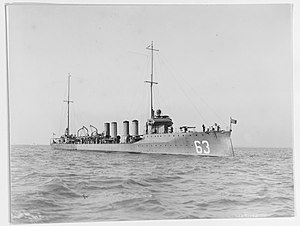USS Sampson (DD-63)
USS Sampson (DD-63) was the lead ship of her class of destroyers of the United States Navy. She was the first Navy ship named for Admiral William T. Sampson (1840–1902).
 USS Sampson (DD-63) | |
| History | |
|---|---|
| Name: | USS Sampson |
| Namesake: | Admiral William T. Sampson (1840–1902) |
| Builder: | Fore River Shipbuilding Company |
| Laid down: | 21 April 1915 |
| Launched: | 4 March 1916 |
| Commissioned: | 27 June 1916 |
| Stricken: | 7 January 1936 |
| Identification: | DD-63 |
| Fate: | Sold 8 September 1936 to Boston Iron and Metal Co. Inc., Baltimore, MD for $18,750.00 and scrapped. |
| General characteristics | |
| Class and type: | Sampson-class destroyer |
| Displacement: | 1,111 tons (normal), 1,225 tons (full load) |
| Length: | 315 ft 3 in (96.09 m) |
| Beam: | 30 ft 7 in (9.32 m) |
| Draft: | 10 ft 9 in (3.28 m) |
| Propulsion: |
|
| Speed: | 29.5 knots (54.6 km/h) |
| Complement: | 99 officers and crew |
| Armament: |
|
Sampson was laid down on 21 April 1915 by the Fore River Shipbuilding Company of Quincy, Massachusetts, launched on 4 March 1916, sponsored by Miss Marjorie Sampson Smith, and commissioned at the Boston Navy Yard on 27 June 1916, Commander B. C. Sampson in command.
Service history
World War I
Torpedo-boat destroyer Sampson was assigned to Division 9 of the Atlantic Destroyer Force and conducted shakedown training out of Narragansett Bay. During the First World War she was commanded by Lieutenant Commander Mark L. Hersey, Jr. - the son of Major General Mark L. Hersey. Hersey received the Navy Cross for distinguished service while commanding the Sampson and would rise to the rank of commodore during the Second World War.
After war games off Provincetown, Massachusetts, Sampson cleared Tompkinsville, New York on 15 May 1917 to join the escort screen of a convoy which touched at Halifax and reached Queenstown, Ireland, on 25 May 1917. She reported for duty with the United States Naval Forces operating in European waters and was assigned to convoy escort duty in the approaches to the British Isles, basing her operations from Queenstown. Two British-type depth charge projectors were installed on her stern; and, on 29 May, she commenced escort duty and protected the troop transports and merchant convoys from hostile submarines throughout the remainder of World War I.
On 18 June 1917, Sampson rescued two small boat loads of survivors of the English Monarch and the captain and 13 sailors from Elele. The next morning, she picked up another 17 survivors of Elele; and, on the 20th, she landed all at Queenstown. Sampson answered other distress calls before the end of the war, and she made several attacks to drive off submarines reported or seen near her convoys. She steamed from France with the Queenstown division of destroyers on 29 November 1918 and stood out from Brest Harbor on 12 December to escort President Woodrow Wilson on board George Washington into the harbor. Returning to Queenstown on 14 December, she sailed for home on the 26th and arrived at the New York Navy Yard on 7 January 1919.
Post war
4th Division, 2nd Flotilla Destroyer Force
After repairs in the New York Navy Yard, Sampson was assigned to the 4th Division, 2d Flotilla, of the Destroyer Force and sailed on 22 March 1919 to base her operations from the Naval Torpedo Station at Newport, Rhode Island. She reported to the Inspector of Ordnance for experimental testing of torpedoes and mines, but interrupted this duty in May 1919 to assist in guarding the route of NC-4 during that seaplane's crossing of the Atlantic, the world's first successful trans-oceanic flight.
Fate
Sampson entered the New York Navy Yard on 1 December 1919 for deactivation overhaul which was completed on 14 February 1921.
Towed to the Philadelphia Navy Yard, Sampson was decommissioned on 15 June 1921. She remained inactive during the years that followed, and on 17 July 1935, was ordered scrapped in accordance with the London Treaty for the reduction of naval armaments. Her name was struck from the Navy list on 7 January 1936, and she was sold for scrap on 8 September 1936 to Boston Iron and Metal Company, Inc., Baltimore, Maryland.
See also
- List of United States Navy destroyers
External links
| Wikimedia Commons has media related to USS Sampson (DD-63). |
This article incorporates text from the public domain Dictionary of American Naval Fighting Ships. The entry can be found here.